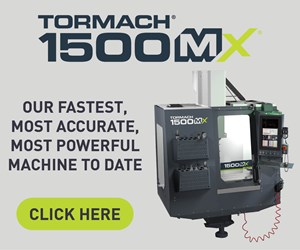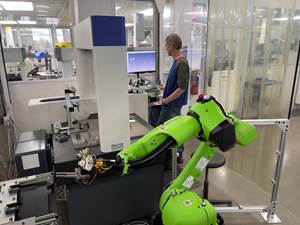EMO 2017 and the Rise of Invisible Innovation
The trade show this year showcased a type of technology that is becoming increasingly difficult to display at trade shows.
At the fairgrounds in Hannover, Germany, where EMO is held, the doors to all the exhibit halls have “no photography” symbols: camera icons with a slash through them. These symbols are relics. Because essentially everyone at the show now has a camera in the form of a cellphone, the 130,000 attendees probably brought more than that many cameras. Controlling photography would have been impossible, and as far as I could see, no one tried. Photos were being taken by impressed attendees everywhere, and the symbol on the doors went unacknowledged or unseen.
And yet, that very symbol might offer a fitting description of the show this year. Unlike a manufacturing expo of years past in which visible and photogenic new machine and hardware designs could be expected to headline the show, some of the most significant advances this year related to invisible capabilities—digital capabilities—that would be impossible to capture in a photograph.
EMO Hannover, which was held in September, is the largest metalworking trade fair in the world. It is also the most international. Metalworking technology companies from around the world (frequently companies I have never heard of, because they are stronger in their home markets than in the U.S.) come here to exhibit within the various separate halls on the expansive Hannover exhibition grounds. Indeed, companies frequently come here to invest in large booths where they can show the range of their offerings or some of the largest of their machines. The result is a sprawling show. With good reason, a shuttle the size of a city bus runs a regular route among this show’s 16 exhibit-filled buildings.
Still, an example of a company that took a very different approach to exhibiting at the show this year was Fastems. This Finnish company is almost certainly best known for pallet systems. A Fastems pallet system mates with horizontal machining centers, independent of their brand, to turn standalone HMCs into stations in a flexible cell. But this year, Fastems had no pallet system on display.
The company offered demonstrations of its Manufacturing Management Software (MMS) instead. This software, which perhaps was developed at first to oversee a pallet system and the machines it serves, now has advanced into version 6 to become potentially the most powerful and valuable of the products the company offers. By managing capacity on various machines in the shop, by tracking machines’ resources such as their available tooling, and by optimizing the scheduling of jobs through machines whether they are connected by a pallet system or not, the MMS is a digital asset for unlocking the productivity of physical hardware. It even assists in quoting, because it allows the shop to run potential scheduling scenarios to see how and in what way existing jobs would be affected if the shop accepted a given job it is considering.
Fastems was exhibiting at EMO in a special Industry 4.0 area of the show. I told the company’s Rolf Hammerstein I was surprised by this—I know Fastems for pallet changing. He said the aim was to address that very association. The company is all about maximizing the use of productive capacity, he says. Physical and digital tools both serve that aim, and frequently it is the latter that offers shops the most promise.
Industry 4.0 was the theme of EMO. More specifically, the theme as written by the show’s organizers was “Connecting systems for intelligent production.” The embrace of this theme strayed toward the overblown. In some cases, equipment providers seeming to offer not much more connectedness than a USB port trumpeted their readiness for Industry 4.0. And I don’t think that trumpeting much mattered, because I doubt a serious equipment buyer was shopping on the basis of whether that equipment could claim a fit with a concept that is still so broad and vague in its outlines. But even so, even if the outlines may be vague for now, those outlines still contain an important idea, and maybe the most important idea that manufacturers now confront. Namely: Interconnectedness allowing for freely flowing data up and down manufacturing processes and organizations will allow for freedoms, capabilities and efficiencies we haven’t yet imagined. Fastems was in the Industry 4.0 area because it sees this promise and wants others to see it, too.
Or “see” it, quote marks added. The advance of all that is signified by the term Industry 4.0 will generally mean that the most impactful manufacturing technologies from now on will often be difficult to observe from the aisle of a trade show.
Another exhibitor, Siemens, has always struggled with a problem like this. The company’s advances are usually digital. At a trade show, it therefore needs to search for the way to populate its displays with clear demonstrations of its technologies’ payoffs. Siemens did this by organizing its booth to show the creation of a part from concept through production to illustrate the software and CNC capabilities it now offers for steps such as design, moldmaking, machining and 3D printing. And to illustrate its connectivity and enterprise-level capabilities, the company showed its real-time monitoring of 240 machine tools in other booths throughout the show.
Yet this year there was a difference, a new digital capability added to the mix that was difficult to display or demonstrate even in contexts such as these. Through its relationship with California startup Identify3D, Siemens now offers capability on its CNCs allowing buyers of machined parts to control the parameters, quantity and expiration window in which their parts are machined. That is, the CNC now offers protection around the standards and the IP of engineered parts. This is an important development, and one I expect we will cover further, but it is a hard development to convey in a visual way and therefore hard to get across in a trade show exhibit.
But now let me talk about robots. This point I am making about Industry 4.0-related developments being invisible only goes so far. Robots are perhaps the limit at which this point stops.
Indeed, robots are where this point gets turned on its head. At one time at trade shows, a robot loading a machine was a sight worth pausing in the aisle to watch. That is not the case anymore. Robots are no longer novel at trade shows because they are no longer novel in shops. Yet Industry 4.0 will make robots novel again, because enhanced digital automation will go gripper-in-gripper with enhanced physical automation. Industry 4.0 will entail (I am making up this term) Robot 2.0.
Among the more talked-about demonstrations at EMO was a glimpse of this seen in Makino’s booth. An autonomous mobile robot there traveled among three different machine tools to load and unload tooling at these machines. Following no rail and no wire, the robot consisted of a collaborative arm mounted on an automated wheeled vehicle. The robot (or maybe “droid” would be fitting, because it looked like something the Jawas in “Star Wars” would sell) found its way to every machine using its own self-driving ability, then found its position precisely by using its pressure-sensitive arm and gripper to feel for the location of every object it needed to grab. In a truly data-interconnected facility, one could easily imagine a machine tool in need of attention summoning a robot just like this one to come wheeling from across the plant to deliver some needed tool, or even to clear some unexpected obstacle away so that unattended production could continue.
Here is video I took of this robot, again regrettably in defiance of the icon on the hall doors:
Related Content
Beyond the Machines: How Quality Control Software Is Automating Measurement & Inspection
A high-precision shop producing medical and aerospace parts was about to lose its quality management system. When it found a replacement, it also found a partner that helped the shop bring a new level of automation to its inspection process.
Read MoreBuilding an Automation Solution From the Ground Up
IMTS 2022 provides visitors the opportunity to meet with product experts to design automation solutions from scratch.
Read MoreWhich Approach to Automation Fits Your CNC Machine Tool?
Choosing the right automation to pair with a CNC machine tool cell means weighing various factors, as this fabrication business has learned well.
Read MoreInside the Premium Machine Shop Making Fasteners
AMPG can’t help but take risks — its management doesn’t know how to run machines. But these risks have enabled it to become a runaway success in its market.
Read MoreRead Next
The Cut Scene: The Finer Details of Large-Format Machining
Small details and features can have an outsized impact on large parts, such as Barbco’s collapsible utility drill head.
Read MoreObscure CNC Features That Can Help (or Hurt) You
You cannot begin to take advantage of an available feature if you do not know it exists. Conversely, you will not know how to avoid CNC features that may be detrimental to your process.
Read More3 Mistakes That Cause CNC Programs to Fail
Despite enhancements to manufacturing technology, there are still issues today that can cause programs to fail. These failures can cause lost time, scrapped parts, damaged machines and even injured operators.
Read More
.jpg;width=70;height=70;mode=crop)















.png;maxWidth=300;quality=90)









